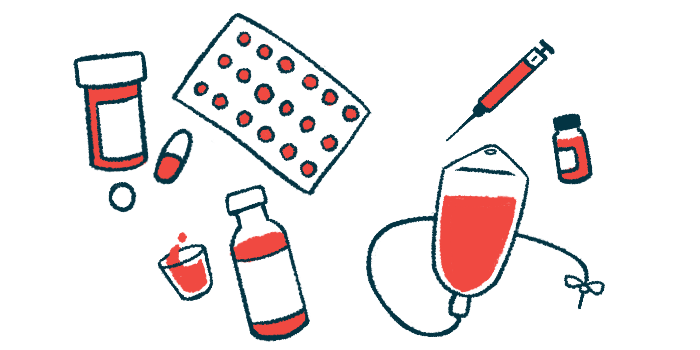CAD treatment needs to be individually tailored: Review study
Symptoms, complications vary among patients, researchers say
Written by |

Decisions about cold agglutinin disease (CAD) treatment need to be made on a case-by-case basis, considering each patient’s specific situation, a pair of scientists in Italy argued in a review study.
The scientists reviewed available and up-and coming treatment options for CAD, giving advice for how best to employ available therapies, in the study, “The evolving management algorithm for the patient with newly diagnosed cold agglutinin disease,” which was published in Expert Review of Hematology.
CAD is an autoimmune disorder in which B-cells, a type of immune cell, produce antibodies, called cold agglutinins, that stick to healthy red blood cells at low temperatures. This activates a set of inflammatory proteins called the complement cascade, and ultimately results in red blood cell destruction.
A loss of red blood cells, which carry oxygen through the bloodstream, results in anemia, depriving tissues of oxygen. This can cause CAD symptoms such as pale skin, circulatory problems, fatigue, and pain.
But specific disease manifestations can vary widely from person to person. Some people with CAD have very mild symptoms and some have severe, life-threatening complications. Most patients are somewhere in the middle of this spectrum. “Therefore, it is difficult to design a unique therapeutical algorithm and therapy should be evaluated on a case-by-case basis,” the researchers wrote.
Supplements, transfusions, medications
The researchers noted that patients with very mild anemia and circulatory symptoms may need minimal medical intervention, such as cold avoidance, folic acid to help with the formation of new red blood cells, and occasional blood transfusions.
On the other end of things, management of severe CAD cases may include powerful anti-inflammatory agents called corticosteroids, blood transfusions and a blood-cleaning procedure called plasmapheresis, as well as steps to keep the body warm and preventive treatment to reduce the risk of blood clot-related complications.
For most patients showing symptoms of anemia, marked fatigue, or important circulatory symptoms, CAD treatment “should be aimed at suppressing the two main [underlying] mechanisms of CAD, namely [cold agglutinin] production and complement activation,” the scientists wrote.
First-line treatment for CAD usually involves rituximab, a B-cell-depleting therapy sold in the U.S. as Rituxan and with generics available. While it isn’t formally approved to treat CAD, it’s pretty well established as a frontline treatment.
However, rituximab has some notable drawbacks. Studies show that only about half of CAD patients will respond to the medication, and responses tend to be short-lived, with most responding patients experiencing disease recurrence within about a year.
Other treatments known to kill B-cells, such as daratumumab, bortezomib, and ibrutinib, have also been reported to be effective for some CAD cases.
“Although strong evidence is lacking, these drugs may be considered in rituximab-refractory/relapsed patients, due to their manageable toxicity,” the researchers wrote.
Adapting treatment to age, preferences, disease course
The scientists noted that treatments targeting B-cells usually take some time for their effects to kick in, so to quickly resolve acute symptoms or effectively manage severe cases, they should be used in combination with treatments that block the complement cascade.
One of these therapies, Enjaymo (sutimlimab-jome) from Sanofi, recently became the first medicine to win approval for CAD in the U.S. and Europe. This approval makes insurance providers more likely to cover the medication. Coverage has historically been an issue with rituximab, which is used off label in CAD.
While Enjaymo carries a hefty price tag and still isn’t available in much of the world, it may help to manage CAD rapidly in an acute/severe setting, and be useful for patients not responding to rituximab or other B-cell-targeting therapies, the scientists noted.
Still, available data suggest that complement-blocking treatments usually aren’t as good as B-cell-targeting medicines at managing cold-induced circulatory symptoms in the extremities.
And while B-cell-depleting therapies typically involve “a time-limited treatment aimed at curing the disease,” complement-blocking treatments “may require long-term fortnightly [into-the-vein] infusions” the researchers wrote.
“The comprehensive armamentarium here described may adapt to patient’s age, comorbidity, and preferences, as well as fit with disease characteristics and clinical course,” the researchers wrote. “Real-world experience in complex cases currently excluded from trials would certainly add knowledge to CAD management and ameliorate the therapeutical algorithm.”
They also noted that several experimental therapies are currently in clinical development for CAD, including both new treatments that target B-cells and therapies that block the complement cascade.
Investigational B-cell-targeting therapies include zanubrutinib — which was scheduled to be tested in a Phase 2 trial (NCT06067048) — and povetacicept, which is being evaluated in a Phase 1/2 trial, called RUBY-4 (NCT05757570), which is currently recruiting.
Among complement-suppressing treatments, Sanofi’s potential successor to Enjaymo, SAR445088, is currently being tested in a long-term Phase 1 study (NCT04802057) after showing promise in previous early trials.
The researchers highlighted, however, that “high costs of novel therapies could be a significant barrier for the real-world application in many healthcare settings.”





